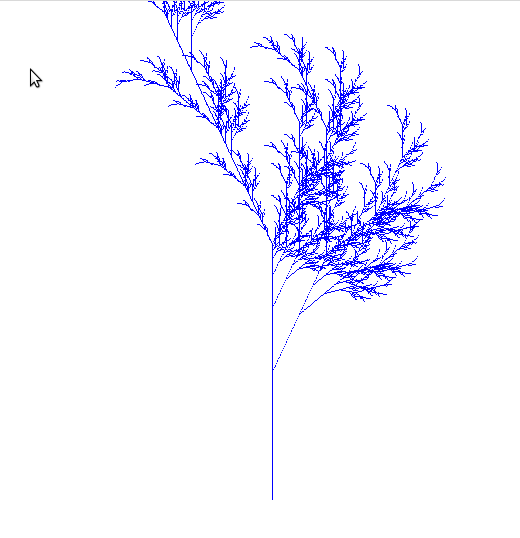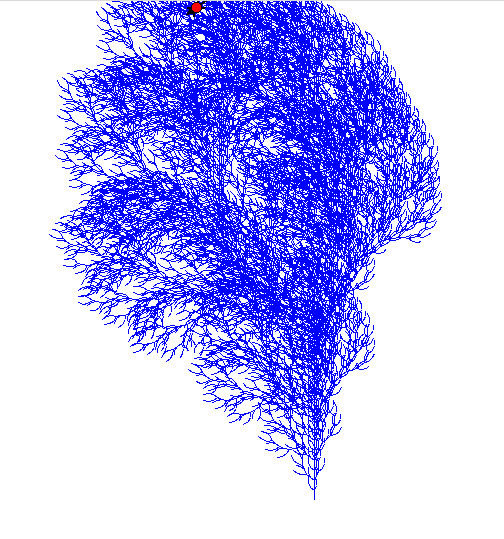User:Laurier Rochon/prototyping/l-systems: Difference between revisions
| Line 5: | Line 5: | ||
It actually appears that Python has built-in turtle graphics, meaning that we can bypass BOB (being in the 'swampy folder' etc., and just use a 'pointer' triangle, with much clearer methods. [http://docs.python.org/library/turtle.html This] is the page for it. It's well documented - for example, you can use 'setcoords(x,y)' to set the pointer at the right spot. The method 'getheading' is also tremendously useful in knowing what angle bob is oriented towards. One big problem with turtle vs turtle world : it's slowwwwwwwwwwwwww. Max speed is '10', which equates to about '1' in Turtle World terms. | It actually appears that Python has built-in turtle graphics, meaning that we can bypass BOB (being in the 'swampy folder' etc., and just use a 'pointer' triangle, with much clearer methods. [http://docs.python.org/library/turtle.html This] is the page for it. It's well documented - for example, you can use 'setcoords(x,y)' to set the pointer at the right spot. The method 'getheading' is also tremendously useful in knowing what angle bob is oriented towards. One big problem with turtle vs turtle world : it's slowwwwwwwwwwwwww. Max speed is '10', which equates to about '1' in Turtle World terms. | ||
--- | |||
--------------------------------- | |||
== Going green with recursive algorithms == | |||
Rules: | |||
*X -> F-[[X]+X]+F[+FX]-X | |||
*F -> FF | |||
Interpretation: | |||
*Start symbol = X | |||
*F = forward 2 | |||
*+ = right 25 | |||
*- = left 25 | |||
[[File:tree1.png]] | |||
Rule: | |||
*F -> FF-[-F+F+F]+[+F-F-F] | |||
Interpretation: | |||
*Start symbol = F | |||
*F = forward 5 | |||
*+ = right 25 | |||
*- = left 25 | |||
[[File:tree2.png]] | |||
--------------------------------- | |||
Using basic transformation rules such as : | Using basic transformation rules such as : | ||
| Line 29: | Line 66: | ||
[[File:Sss1.png]] | [[File:Sss1.png]] | ||
== Soft == | |||
(with TurtleWorld) | |||
<source lang='python'> | |||
from TurtleWorld import * | |||
world = TurtleWorld() | |||
bob = Turtle() | |||
#make it FAST! | |||
bob.delay = 0.0001 | |||
#draw upwards, plz | |||
lt(bob,90) | |||
#gimme some room...we'll fullscreen the window | |||
bob.x=200 | |||
bob.y=-300 | |||
#starting axiom | |||
n = 'X' | |||
#replacement rules | |||
s1 = 'X' | |||
s2 = 'F-[[X]+X]+F[+FX]-X' | |||
s3 = 'F' | |||
s4 = 'FF' | |||
#number of steps | |||
steps = 7 | |||
for i in range(steps): | |||
#apply the rules, do the replacements | |||
n = n.replace(s1,s2) | |||
n = n.replace(s3,s4) | |||
#angle to turn | |||
a = 25 | |||
#declare my arrays | |||
xx = [] | |||
yy = [] | |||
angle = [] | |||
#go through all characters of my string | |||
for i in n: | |||
#go forward | |||
if i == 'F': | |||
bob.fd(1) | |||
#turn left | |||
if i == '+': | |||
bob.lt(a) | |||
#turn right | |||
if i == '-': | |||
bob.rt(a) | |||
#record current state | |||
if i=='[': | |||
xx.append(bob.get_x()) | |||
yy.append(bob.get_y()) | |||
angle.append(bob.get_heading()) | |||
#restore last state... | |||
if i==']': | |||
#we're gonna move around, put the pen up | |||
bob.pu() | |||
#change x and y | |||
bob.x = xx[len(xx)-1] | |||
bob.y = yy[len(yy)-1] | |||
#cancel whatever angle you're in | |||
bob.rt(bob.get_heading()) | |||
#turn to new angle | |||
bob.heading = angle[len(angle)-1] | |||
#pop the x,y and angle off their stacks | |||
xx.pop() | |||
yy.pop() | |||
angle.pop() | |||
#ready to draw again... | |||
bob.pd() | |||
wait_for_user() | |||
</source> | |||
Revision as of 01:14, 13 June 2011
L-Systems
Discovery of the day : TURTLE! (not TurtleWorld, the library)
It actually appears that Python has built-in turtle graphics, meaning that we can bypass BOB (being in the 'swampy folder' etc., and just use a 'pointer' triangle, with much clearer methods. This is the page for it. It's well documented - for example, you can use 'setcoords(x,y)' to set the pointer at the right spot. The method 'getheading' is also tremendously useful in knowing what angle bob is oriented towards. One big problem with turtle vs turtle world : it's slowwwwwwwwwwwwww. Max speed is '10', which equates to about '1' in Turtle World terms.
Going green with recursive algorithms
Rules:
- X -> F-[[X]+X]+F[+FX]-X
- F -> FF
Interpretation:
- Start symbol = X
- F = forward 2
- + = right 25
- - = left 25
Rule:
- F -> FF-[-F+F+F]+[+F-F-F]
Interpretation:
- Start symbol = F
- F = forward 5
- + = right 25
- - = left 25
Using basic transformation rules such as :
- Axiom: F-F-F-F
- Rule : F -> FF-F-F-F-FF
- Angle: 90
- Steps: 4
What the symbols mean
- F is forward by X pixels
- + is turn Y degrees
- - is turn -Y degrees
- [ is record the current state
- ] restore the matching last ] state
Will yield something like :
Other set of rules...
Soft
(with TurtleWorld)
from TurtleWorld import *
world = TurtleWorld()
bob = Turtle()
#make it FAST!
bob.delay = 0.0001
#draw upwards, plz
lt(bob,90)
#gimme some room...we'll fullscreen the window
bob.x=200
bob.y=-300
#starting axiom
n = 'X'
#replacement rules
s1 = 'X'
s2 = 'F-[[X]+X]+F[+FX]-X'
s3 = 'F'
s4 = 'FF'
#number of steps
steps = 7
for i in range(steps):
#apply the rules, do the replacements
n = n.replace(s1,s2)
n = n.replace(s3,s4)
#angle to turn
a = 25
#declare my arrays
xx = []
yy = []
angle = []
#go through all characters of my string
for i in n:
#go forward
if i == 'F':
bob.fd(1)
#turn left
if i == '+':
bob.lt(a)
#turn right
if i == '-':
bob.rt(a)
#record current state
if i=='[':
xx.append(bob.get_x())
yy.append(bob.get_y())
angle.append(bob.get_heading())
#restore last state...
if i==']':
#we're gonna move around, put the pen up
bob.pu()
#change x and y
bob.x = xx[len(xx)-1]
bob.y = yy[len(yy)-1]
#cancel whatever angle you're in
bob.rt(bob.get_heading())
#turn to new angle
bob.heading = angle[len(angle)-1]
#pop the x,y and angle off their stacks
xx.pop()
yy.pop()
angle.pop()
#ready to draw again...
bob.pd()
wait_for_user()




